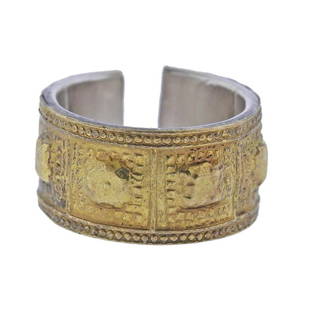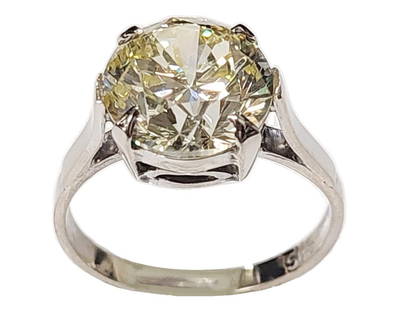
Greek Core-Form Glass Alabastron
Similar Sale History
View More Items in Band Rings
Related Band Rings
More Items in Band Rings
View MoreRecommended Rings
View More





Item Details
Description
Ancient Greece, Eastern Mediterranean, Classical Period, ca. late 6th to early 5th century BCE. A lovely core-formed glass alabastron, so named because many vessels that assumed this form were made of alabaster. The opaque vessel is comprised of deep cobalt blue glass with tangerine and white trailing combed into a feathered zigzag pattern to adorn the body, and a circular tangerine band ringing the flared rim. Several shallow pattern-molded ribs surround the body, and a pair of petite lug handles is set on the shoulder. A stunning work of expert glass blowing with gorgeous hues and an elegant presentation. Size: 4.25" H (10.8 cm)
The alabastron is a long-bodied vessel with a rounded bottom, a cylindrical neck, and a flat disk for a mouth. Though usually without handles, some alabastra do boast small curving handles, like this example. According to the Beazley Archive of the University of Oxford, the alabastron shape's history extends back to Corinth, but was only preserved in Athenian pottery examples back to the mid-sixth century BCE. Alabastra were created in many materials, including alabaster, and the Greek term for this stone - alabastron (most likely of Egyptian origin) - was the source of inspiration for the name of this shaped vessel. Many examples were finished with a white ground, as if to imitate this stone. We know from vase painting imagery of women using alabastra following a bath, that these vessels most likely held perfumed oils.
According to the Corning Museum of Glass, core forming is "the technique of forming a vessel by winding or gathering molten glass around a core supported by a rod. After forming, the object is removed from the rod and annealed. After annealing, the core is removed by scraping." (https://www.cmog.org/glass-dictionary/core-forming). This process of glass making was begun in the late 16th century BCE by glassmakers of Mesopotamia, and then adopted by Egyptian glassmakers in the 15th century BCE. The technique almost came to an end in the so-called Dark Ages of Mediterranean civilization (1200 to 900 BCE); however, by the 9th century BCE a new generation of glassmakers took up the technique once again, and between the 6th and 4th century BCE core-forming spread throughout the Mediterranean.
Provenance: private East Coast, USA collection
All items legal to buy/sell under U.S. Statute covering cultural patrimony Code 2600, CHAPTER 14, and are guaranteed to be as described or your money back.
A Certificate of Authenticity will accompany all winning bids.
We ship worldwide to most countries and handle all shipping in-house for your convenience.
#136299
The alabastron is a long-bodied vessel with a rounded bottom, a cylindrical neck, and a flat disk for a mouth. Though usually without handles, some alabastra do boast small curving handles, like this example. According to the Beazley Archive of the University of Oxford, the alabastron shape's history extends back to Corinth, but was only preserved in Athenian pottery examples back to the mid-sixth century BCE. Alabastra were created in many materials, including alabaster, and the Greek term for this stone - alabastron (most likely of Egyptian origin) - was the source of inspiration for the name of this shaped vessel. Many examples were finished with a white ground, as if to imitate this stone. We know from vase painting imagery of women using alabastra following a bath, that these vessels most likely held perfumed oils.
According to the Corning Museum of Glass, core forming is "the technique of forming a vessel by winding or gathering molten glass around a core supported by a rod. After forming, the object is removed from the rod and annealed. After annealing, the core is removed by scraping." (https://www.cmog.org/glass-dictionary/core-forming). This process of glass making was begun in the late 16th century BCE by glassmakers of Mesopotamia, and then adopted by Egyptian glassmakers in the 15th century BCE. The technique almost came to an end in the so-called Dark Ages of Mediterranean civilization (1200 to 900 BCE); however, by the 9th century BCE a new generation of glassmakers took up the technique once again, and between the 6th and 4th century BCE core-forming spread throughout the Mediterranean.
Provenance: private East Coast, USA collection
All items legal to buy/sell under U.S. Statute covering cultural patrimony Code 2600, CHAPTER 14, and are guaranteed to be as described or your money back.
A Certificate of Authenticity will accompany all winning bids.
We ship worldwide to most countries and handle all shipping in-house for your convenience.
#136299
Condition
Repaired from 3-6 large pieces. Expected surface wear commensurate with age. Areas of gorgeous rainbow and silvery iridescence.
Buyer's Premium
- 24.5%
Greek Core-Form Glass Alabastron
Estimate $3,000 - $4,500
6 bidders are watching this item.
Shipping & Pickup Options
Item located in Louisville, CO, usSee Policy for Shipping
Payment

Related Searches
TOP





























































